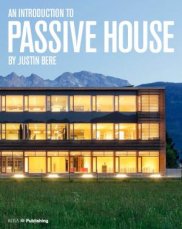Main author
Michael BrooksAn Introduction to Passive House - review
Justin Bere - ‘An Introduction to Passive House’
Published by RIBA Publishing (2013)
Written by the architect Justin Bere, this introductory guide to the Passive House standard is an accessible and valuable addition to the growing content relating to construction fit for a sustainable 21st century.
The slim and well-presented volume begins with a section called ‘What is Passive House?’ which concisely explores the history and growing prevalence of the Passivhaus Standard. Bere explains that Passive House is a standard for, and advanced method of, designing buildings using building physics to ensure precision, comfort and reduced energy costs, as well as removing guesswork from the design process.
He also presents the opinion that:‘A great 21st century building is one that is beautiful to look at but that also feels good in reality when the power supplies are turned down to almost nothing … I fear that some architects give more priority to how their buildings will look in architectural magazines than to making sure that their buildings perform efficiently and comfortably for the benefit of their occupants.’
The book explores the six methods that form the essential basics of Passive House design:
- Insulation.
- Draught-free construction.
- High-performance windows and doors.
- Heat recovery ventilation.
- Good building commissioning.
- Solutions for both hot and cold climates.
While the book does not provide a great deal of detail, Bere does set out the context and easy-to-understand basics for those who may not be familiar with the subject.
The second section asks ‘Why Passive House?’, and provides more technical information and discussion covering the renewable energy revolution, integrated design, and capital and whole life costs. Two shorter chapters provide robust primers on air quality and health, and the importance of skills.
The bulk of the book though is taken up with 15 case studies from around the world. These include a variety of different buildings other than houses, including an office, community centre and school, and emphasise the potential that following the Passive House Standard can have in delivering buildings of great architectural merit.
There are eye-catching photographs, details and diagrams throughout that make it a great book to flick through, while providing enough technical information to serve as a worthwhile and engaging introduction, and perhaps as inspiration, to both students and seasoned professionals.
[edit] Related articles on Designing Buildings
- Active House.
- Ancona eco-mansion.
- Better Buildings: Learning from buildings in use - review.
- Bill Gething and Katie Puckett - Design for Climate Change.
- BIM for Dummies - an interview.
- Biomimicry in Architecture - review.
- Charles Waldheim - Landscape as Urbanism: A General Theory.
- Fabric first.
- FutuREstorative - review.
- Green deal.
- Home Quality Mark.
- How Buildings Work - review.
- Owen Hatherley - Landscapes of Communism.
- Passivhaus.
- Sustainability.
- Zero carbon homes.
Featured articles and news
Homes England creates largest housing-led site in the North
Successful, 34 hectare land acquisition with the residential allocation now completed.
Scottish apprenticeship training proposals
General support although better accountability and transparency is sought.
The history of building regulations
A story of belated action in response to crisis.
Moisture, fire safety and emerging trends in living walls
How wet is your wall?
Current policy explained and newly published consultation by the UK and Welsh Governments.
British architecture 1919–39. Book review.
Conservation of listed prefabs in Moseley.
Energy industry calls for urgent reform.
Heritage staff wellbeing at work survey.
A five minute introduction.
50th Golden anniversary ECA Edmundson apprentice award
Showcasing the very best electrotechnical and engineering services for half a century.
Welsh government consults on HRBs and reg changes
Seeking feedback on a new regulatory regime and a broad range of issues.
CIOB Client Guide (2nd edition) March 2025
Free download covering statutory dutyholder roles under the Building Safety Act and much more.
Minister quizzed, as responsibility transfers to MHCLG and BSR publishes new building control guidance.
UK environmental regulations reform 2025
Amid wider new approaches to ensure regulators and regulation support growth.
BSRIA Statutory Compliance Inspection Checklist
BG80/2025 now significantly updated to include requirements related to important changes in legislation.
























